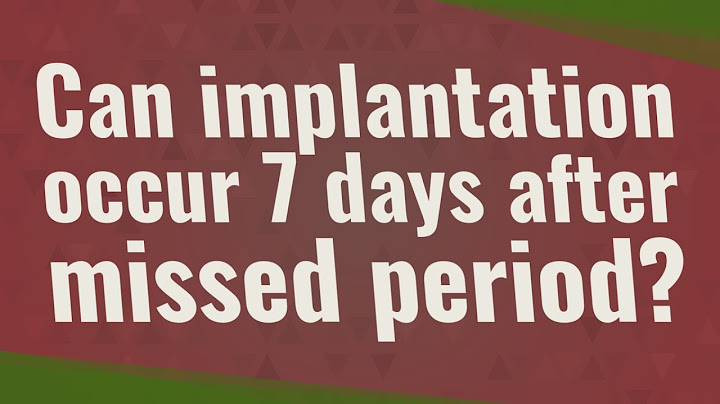When you're trying to conceive, it's hard to wait the two weeks or so between your fertile days and taking an at-home pregnancy test. During this period of anticipation, it's natural to interpret the slightest change in your body as a possible sign of pregnancy. The only thing worse than getting your hopes up because you feel a little more tired or out of breath than usual, is to mistake implantation bleeding for your period and assume you're not pregnant. So what color is implantation bleeding? It's time you learn to tell the difference between this early sign of pregnancy and your regular menstrual cycle. Show Over email, Romper interviewed three OB-GYNs about implantation bleeding. Their descriptions each differ slightly, but all agree that implantation bleeding is lighter in flow and a different color than your regular period. It's "usually brown," says Miao Crystal Yu, OB-GYN at Saddleback Medical Center in Laguna Hills, California. Yu elaborates that implantation bleeding is "a little bit of brownish spotting that occurs when the embryo implants." This matches the characterization Gerardo Bustillo of MemorialCare Medical Group in Fountain Valley, California, gives implantation bleeding, too. According to Bustillo, implantation bleeding doesn't necessarily have a specific color, but "generally the spotting or bleeding is light." OB-GYN Yen Tran of Orange Coast Medical Center in Fountain Valley, California, adds that implantation bleeding may look like "pinkish/rusty old brown bloody discharge." To distinguish implantation bleeding from a normal period, it's helpful to understand the process behind it. According to Tran, "After fertilization occurs in the fallopian tubes around the time of ovulation, the embryo travels down the fallopian tube to attach to the wall of the uterine cavity. During the attachment progress, some blood vessels break down." The broken blood vessels lead to the old blood (i.e. brownish) spotting you may find in your underwear. However, Bustillo notes that implantation bleeding "remains an unproven hypothesis" and "does not occur in the majority of pregnancies." Timing is also important when you're trying to pinpoint the cause of bleeding. Bustillo and Tran say implantation bleeding occurs approximately 10 to 14 days after conception, while Yu gives an earlier estimate of three to seven days post-conception. Since your period isn't due until about two weeks after ovulation, you can probably guess implantation bleeding if you experience light spotting much earlier than that. It can be harder to guess if the bleeding overlaps with when you expect your period. Luckily, there are other differences to help you compare a normal period with implantation bleeding. When asked how a woman can tell whether she is experiencing implantation bleeding or a regular period, Yu says, "Implantation bleeding is much lighter, usually lasting one to two days, not requiring the patient to change pads. If in doubt, talk to your OB-GYN and confirm the diagnosis with blood work or ultrasound." Bustillo also notes that a pregnancy test may be the best way to confirm the cause of your bleeding. "Implantation bleeding, when it does occur, coincides with the time of an anticipated menses. Therefore it can be confusing to know exactly what is going on. Generally, implantation bleeding is spotting only, while a menstrual period is heavier. If the bleeding is accompanied by potential early pregnancy symptoms such as fatigue, nausea/vomiting, and frequent urination, a pregnancy test would be indicated to solve the dilemma." Finally, Tran agrees that implantation bleeding is usually shorter than menstruation and may be accompanied by early pregnancy symptoms. "Most periods last about four to seven days [and are] heavier with a bright red color blood, whereas implantation bleeding comes a few days sooner than the next expected period and only lasts for a few hours to two days only, along with signs like breast tenderness, mild cramping, headache and mild nausea." Related ResourcesRelated Providers Implantation bleeding is bleeding that occurs about two to three weeks after fertilization. Blood from implantation bleeding tends to be pink or rusty brown in color, light flow with no clotting and it lasts for one to three days accompanied by other symptoms. Implantation bleeding is bleeding that occurs in women typically when the fertilized egg (embryo) attaches itself to the lining of the uterus. This usually occurs between 6 and 12 days after conception (successful joining of an egg and a sperm). Implantation bleeding may often be mistaken for a regular period because it may look similar and occur around the same time as a woman’s regular period. Hence, women should be able to recognize whether vaginal bleeding is a result of implantation bleeding and know when to seek medical attention. If a woman suspects that her bleeding is a result of implantation bleeding and not a regular period, she should do a home pregnancy test (urine pregnancy test [UPT]) and consult a doctor. Implantation bleeding occurs in around 25 percent of pregnancies. Facts that distinguish implantation bleeding from menses or miscarriage are as follows.
Understanding the Menstrual CycleDuring every menstrual cycle, an egg develops and is released from one of the ovaries (ovulation). At the same time, the lining of the uterus becomes thicker due to hormonal changes. If pregnancy does not occur, the thickened lining (endometrium) of the uterus sheds through the vagina accompanied by bleeding. Bleeding usually lasts for three to eight days, and this is known as menstruation or period. The menstrual cycle usually lasts between 24 and 38 days but is typically 28 days long. Phases of the menstrual cycle:
How Do You Tell if It’s Implantation Bleeding or a Regular Period?Implantation bleeding is very short-lived, unlike a regular period. It usually only lasts for 24-48 hours, which is the amount of time taken for the fertilized egg to get implanted into the lining of the uterus. Ovulation occurs between Day 14 and 16 and fertilization occurs between Day 18 and 20 of the menstrual cycle. Implantation usually occurs between Day 24 and 26 of the menstrual cycle. Implantation bleeding may occur two to seven days after fertilization. The blood in implantation bleeding is typically dark brown or black, indicating that it’s older blood. Sometimes, it may be red or pink. Blood flow is not heavy, unlike a regular period. Additionally, there may only be some light spotting or a few drops to slightly larger amounts in many cases. Characteristics of a regular period
Characteristics of implantation bleeding
When to Consult a DoctorIf a woman suspects that her bleeding is a result of implantation bleeding and not a regular period, she should do a home pregnancy test (urine pregnancy test [UPT]) and consult a doctor. Implantation bleeding occurs in around 25 percent of pregnancies and is typically not dangerous. However, women should deal with any bleeding during pregnancy with caution. They should consult a doctor for the same if bleeding is very little or there is just spotting. Although not all bleeding is an emergency or a sign of complications, the doctor would advise tests, such as an ultrasound, that are important to evaluate the cause. Bright red blood indicates active bleeding, and it is an emergency, especially if there are blood clots and pain. This could be a sign of something serious such as a miscarriage.  SLIDESHOW16 Early Signs & Symptoms of Pregnancy: Could You Be Pregnant? See SlideshowFrom
 Reviewed on 5/20/2021 References https://americanpregnancy.org/pregnancy-symptoms/what-is-implantation-bleeding-24176/ https://pubmed.ncbi.nlm.nih.gov/12923154/ How many days before your period do you have implantation bleeding?Implantation bleeding tends to occur during the week before you would expect your period, or about six to 12 days after conception. This is around the same time a fertilized egg would be attaching itself to the uterine lining.
Can you spot day before period and be pregnant?Implantation spotting may occur when a fertilized egg attaches to the inner uterine lining. About 15 to 25 percent of pregnant people experience bleeding in early pregnancy. If implantation spotting does occur, it will often happen a few days before your next period begins.
|

Related Posts
Advertising
LATEST NEWS
Advertising
Populer
Advertising
About

Copyright © 2024 muatrau Inc.


















